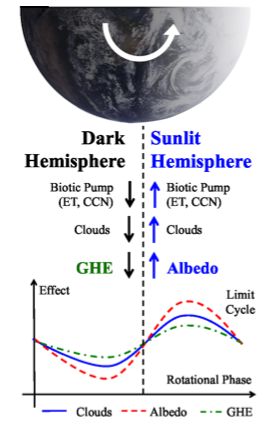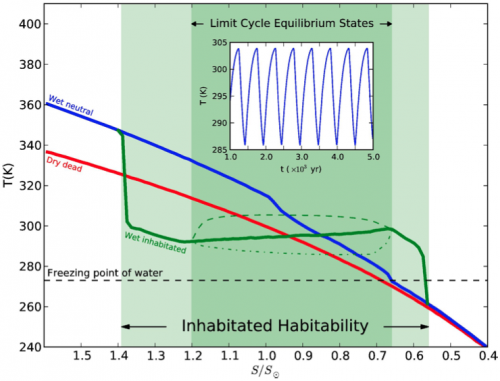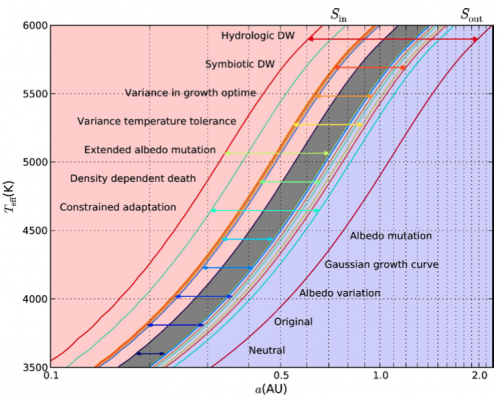The quest for inhabited habitable planets

Which came first: life or habitability? Although this question seems at first sight contradictory, a new paper by Colombian researchers is bringing to the attention of astrobiologists a classical conundrum: Is life also required for habitability? On Earth it is almost a matter of fact that in the same way as habitable conditions on our planet are mandatory for life, the existence of life could also be determinant at making our world permanently habitable. And, if this is the case for Earth, it should be also for other inhabited habitable planets elsewhere. Consequently, if our goal is to find life in the Universe, we should not exclude life itself when predicting on which planets it could thrive.
"We should make things as simple as possible, but not simpler". This is the famous Einstein quote that opens a new paper written by a group of Colombian scientists and accepted for publication in the journal Biogeosciences Discussion. The paper entitled "The Habitable Zone of Inhabited Planets," authored by Jorge I. Zuluaga, FACom researchers and others, cites the quote to highlight the fact that most of the models used today to predict the conditions under which a planet will be habitable are probably simpler than they should be. According to the authors, life has been systematically excluded when calculating the plausible environmental conditions in habitable planets. The situation is paradoxical, since life is the ultimate goal of our search for habitable worlds in the Galaxy.
"It is like trying to design the air conditioning system of a vehicle excluding from the heat and mass balance the effect of passengers inside the cabin; what is the purpose of the air conditioning system if, for designing it, we need to assume that the vehicle is empty?" asks Prof. Jorge I. Zuluaga, leading author of the paper. Although the determinant role of life in the present and past state of Earth's environment has not been definitively probed, there is a growing amount of evidence supporting the idea that our Planet will not be the same if we remove every single form of life from its surface.
"The Earth's environment, and in general, the environment of any planet inhabited by a widespread biota, comprises very complex systems; powerful, though sometimes subtle interactions between their components continuously maintains the system in a regulated equilibrium state", explains Prof. Juan F. Salazar, co-author of the paper and first author of a previous work that inspired this new development. "In such complex systems, excluding any key component could produce very different final conditions; thus, evaluating the habitability of Earth or any other hypothetical planet assuming that they are devoid of life (abiotic habitability) could produce a very different result than assuming that the planet is inhabited".

But the idea that life is important for habitability is not new, as the authors recognize in their paper. It dates back to the original works by the Russian physicist Vladimir Vernadsky circa 1920, who introduced by the first time the concept of "biosphere".
In the second half of the 20th century, the English environmental scientist James Lovelock went further at proposing the "Gaia Hypothesis". According to this hypothesis, the complex system formed by life and its environment, behaves almost as a single organism. This "global organism" is able to self-regulate the environment maintaining the habitable conditions of the planet. More recently, other authors have developed alternative theories leading to similar conclusions. This is the case of the so-called "biotic regulation of the environment" (BRE), a theoretical framework developed by the Russian physicists Victor Gorshkov and Anastasia Makarieva. BRE states that life and its unique properties produce a dominant effect on the environment that regulates it over geological timescales. But if the idea that life affects habitability is actually a recognized idea, what's new in the recent paper?
Several decades of observations of the Earth system, together with the aforementioned theoretical developments studying the interaction between life and its environment, seem not to have had a large impact on exoplanets habitability studies. The current models used to calculate the conditions under which a planet is habitable (i.e. the Habitable Zone) do not include life among the potential effects determining the final state of the planet. Although several authors have developed in the past "biotic" models of habitability, these models have been the exception instead of the rule. What Zuluaga and his collaborators are attempting to do in their paper is first to demonstrate that excluding life from the "habitability equation" is unnatural and probably misleads the search for actually inhabited planets. In the second place, the authors present a general conceptual basis supporting the development of habitability models that include life.
Zuluaga, et al. offer an ingenious example of how a hypothetical complex environment could be habitable under conditions that would otherwise be deadly. What would happen if a planet was half covered by clouds in such a way that the sunlit hemisphere was always cloudy while the dark hemisphere was always clear? The planet could withstand high levels of stellar insolation and probably be "fresh" even at distances well inside the inner edge of the Habitable Zone. But how will a planet maintain such a strange state? How will clouds be "obligated" to synchronously rotate with the planet just to guarantee habitable conditions?
"Life is probably the answer," states Prof. Zuluaga enthusiastically. "Contrary to abiotic processes, living systems contain and maintain impressive amounts of information that give them unparalleled regulatory capabilities."

Zuluaga cites several examples of this condition in our habitable planet. On Earth, for instance, life essentially drives the amount of CO2 in the atmosphere and impacts in powerful ways the formation of clouds. "You just need to include the effect of life in the environment of a planet and unexpected and probably surprising properties and behaviors could arise", he concludes.
Finally, the paper presents the results of a simple numerical model, supporting the researchers' intuitions on the capacity for life to modify the Habitable Zone restrictions. Based on a very popular "toy model" called the "Daisyworld", the model of Zuluaga et al. simulates the dynamics of a planet populated by two species of dark and clear vegetation (black and white daisies). The planet is also covered by dynamic cloud cover, a novel feature among Daisyworld models and even among planetary habitability models. Daisies and clouds interact via evaporation and transpiration, and their mutual dynamics finally determine the surface temperature of the planet. The model, also dubbed "hydrological Daisyworld", was first devised and explored by Salazar and Poveda, also co-authors of this work, who found very interesting and previously unseen emergent properties coming from the interaction between life and the hydrological cycle.
The hydrological Daisyworld behaves exactly how Zuluaga et al. expect: Even with a simple biosphere, an inhabited planet could be habitable (could have warm surface temperatures) even when the stellar insolation was higher or lower than the maximum and minimum levels expected in the most traditional habitability models.
Zuluaga et al. went further and compiled results from more than a dozen Daisyworld models that also exhibited the same behavior. Although far from definitive (and even credible, according to a fraction of the astrobiology community), the results of the Daisyworld models clearly illustrate the central point of the work written by the Colombian researchers: A habitable planet with life and a habitable planet without life are not the same planets.
Whether or not planetary scientists developing habitability models will follow the recommendations of the Colombian authors, it will be probably a matter of scientific or philosophical debate inside the community. A final decision would be even an issue of "numerical convenience," since simulating life is much more complex and uncertain than simulating air, water or rocks. Ultimately, the truth is that finding inhabited, rather than merely habitable, worlds is the actual goal of our ultimate scientific search for life beyond our pale blue dot.
More information: "The Habitable Zone of Inhabited Planets." J.I. Zuluaga, J.F. Salazar, P.A. Cuartas and G. Poveda, Accepted for publication in Biogeosciences Discussion (18 May 2014). arXiv:1405.4576. arxiv.org/abs/1405.4576
Journal information: Biogeosciences
Provided by Universidad de Antioquia




















